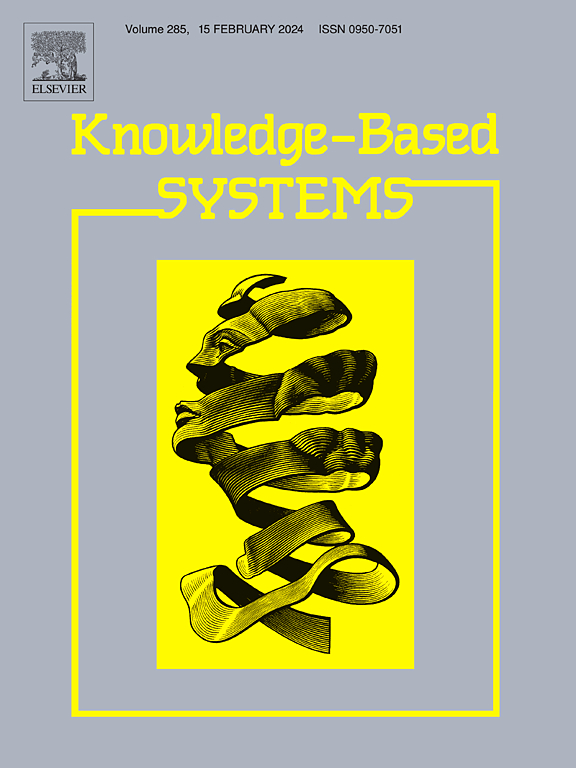USMDA: Unsupervised Multisource Domain Adaptive ADHD prediction model using neuroimaging
IF 7.2
1区 计算机科学
Q1 COMPUTER SCIENCE, ARTIFICIAL INTELLIGENCE
引用次数: 0
Abstract
There is an increasing number of large-scale cross-site database collections of neuroimaging markers (sMRI and fMRI) for studying neurodevelopmental illnesses (NDDs). Although a huge amount of data favors machine learning-based categorization algorithms, the unique heterogeneity of each site can impair cross-site generalization capacity. It is critical to create Unsupervised domain adaption methods for NDDs because obtaining appropriate diagnoses or labeling for NDDs might be problematic. In our work, we focus on Attention-deficit/hyperactivity disorder, which is the most common and frequently co-occurring NDD. We present an unsupervised multisource domain adaptation network (USMDA) with four primary components: Domain Alignment Module, Discrepancy Estimator, Pre-trained Model Generator, and Unsupervised Network. The Domain Alignment module is intended to incrementally and effectively align graph representations of the source and target domains. At the same time, the binary cross entropy regularizer is introduced for the first time during the training of a model learned on multiple source domains to improve existing feature alignment methods such as Transfer Joint Matching (TJM) and Joint Distribution Adaptation (JDA) by learning good unsupervised features. In an unsupervised network, the grid search optimization technique generates the optimal pseudo labels for unlabeled target data. We validate our proposed technique first on existing feature-level DA methods such as JDA, TJM, and Correlation alignment (CORAL), on the publically accessible dataset ADHD-200 and then by using binary cross-entropy in existing DA methods such as TJMCE and JDACE. The experimental results show that our proposed method when applied to multisite sMRI and fMRI ADHD data, can significantly outperform competitive methods for multi-center ADHD diagnosis.
USMDA:利用神经影像的无监督多源领域自适应多动症预测模型
用于研究神经发育疾病(NDDs)的神经影像标记(sMRI 和 fMRI)的大规模跨部位数据库集合越来越多。虽然海量数据有利于基于机器学习的分类算法,但每个部位的独特异质性会损害跨部位归纳能力。为 NDDs 创建无监督领域适应方法至关重要,因为为 NDDs 获取适当的诊断或标记可能存在问题。在我们的工作中,我们重点研究了注意力缺陷/多动障碍,这是最常见、最常并发的 NDD。我们提出的无监督多源领域适应网络(USMDA)包含四个主要组件:领域对齐模块、差异估计器、预训练模型生成器和无监督网络。域对齐模块旨在逐步有效地对齐源域和目标域的图表示。同时,在对多个源域学习的模型进行训练时,首次引入了二元交叉熵正则化器,通过学习良好的无监督特征来改进现有的特征对齐方法,如转移联合匹配(TJM)和联合分布适应(JDA)。在无监督网络中,网格搜索优化技术为未标记的目标数据生成最佳伪标签。我们首先在公开数据集 ADHD-200 上对 JDA、TJM 和 Correlation alignment (CORAL) 等现有特征级分布式计算方法进行了验证,然后在 TJMCE 和 JDACE 等现有分布式计算方法中使用二元交叉熵对我们提出的技术进行了验证。实验结果表明,我们提出的 USMDAJDACE 方法应用于多站点 sMRI 和 fMRI ADHD 数据时,在多中心 ADHD 诊断方面明显优于其他竞争方法。
本文章由计算机程序翻译,如有差异,请以英文原文为准。
求助全文
约1分钟内获得全文
求助全文
来源期刊

Knowledge-Based Systems
工程技术-计算机:人工智能
CiteScore
14.80
自引率
12.50%
发文量
1245
审稿时长
7.8 months
期刊介绍:
Knowledge-Based Systems, an international and interdisciplinary journal in artificial intelligence, publishes original, innovative, and creative research results in the field. It focuses on knowledge-based and other artificial intelligence techniques-based systems. The journal aims to support human prediction and decision-making through data science and computation techniques, provide a balanced coverage of theory and practical study, and encourage the development and implementation of knowledge-based intelligence models, methods, systems, and software tools. Applications in business, government, education, engineering, and healthcare are emphasized.
 求助内容:
求助内容: 应助结果提醒方式:
应助结果提醒方式:


